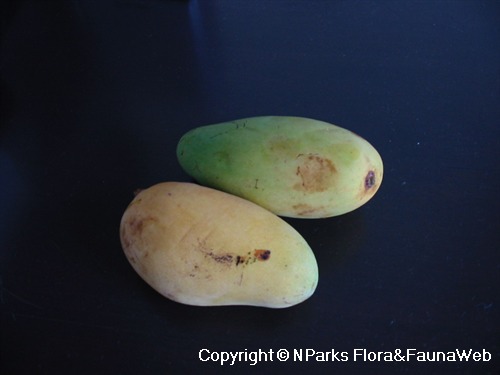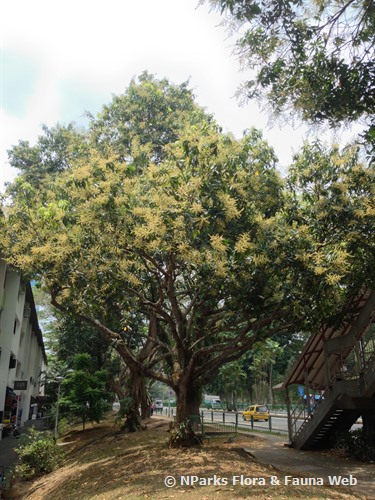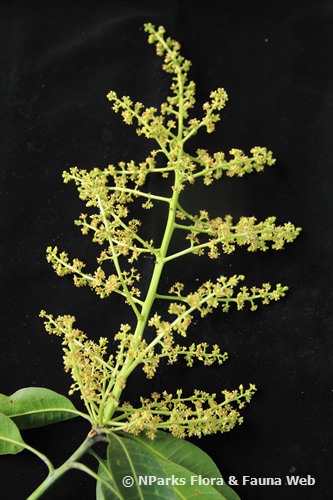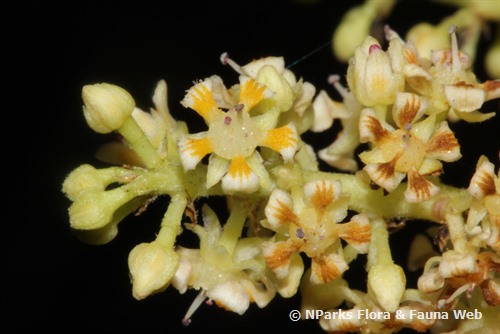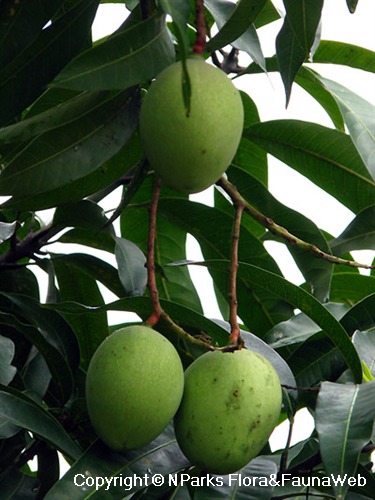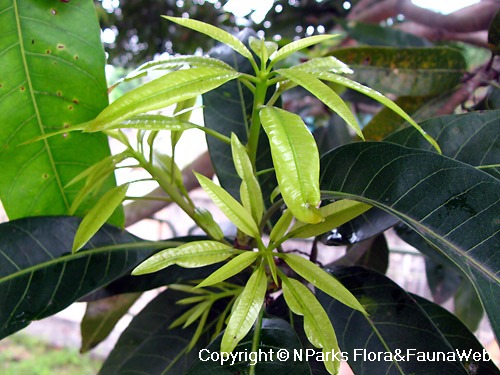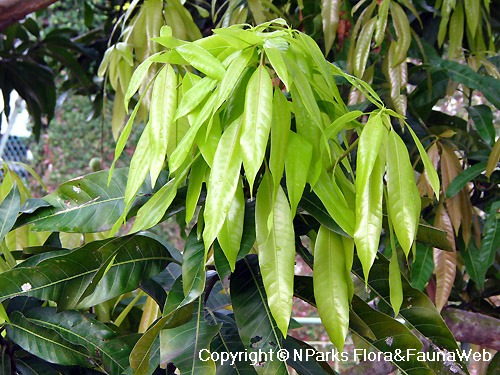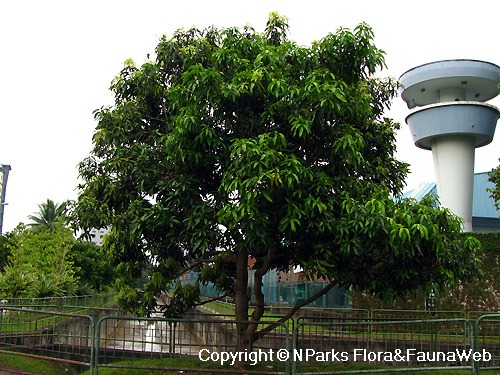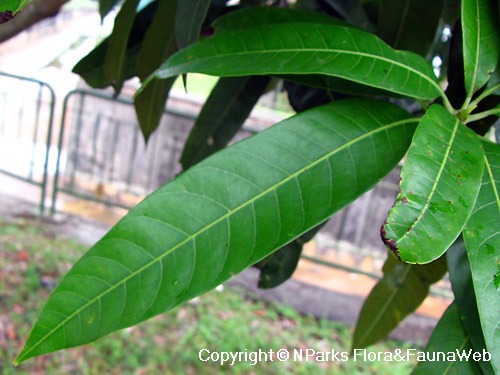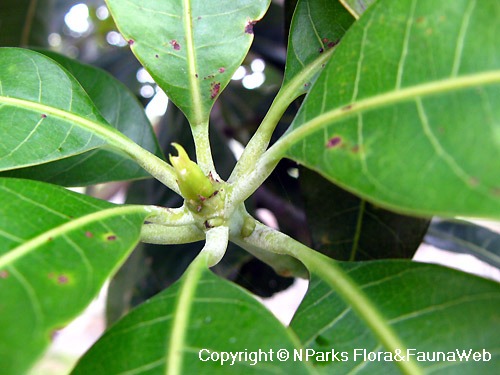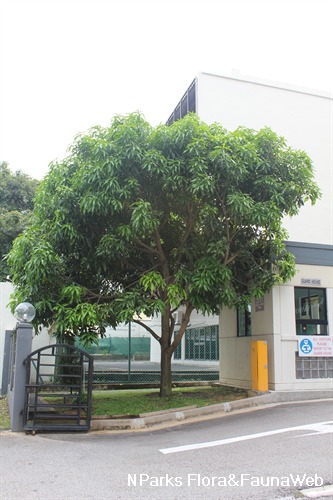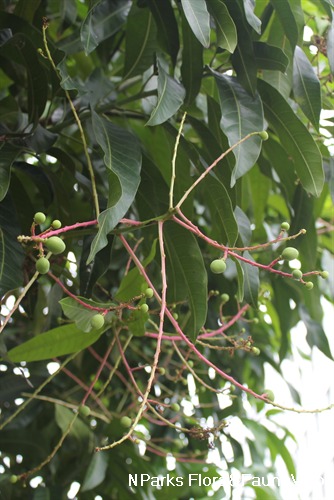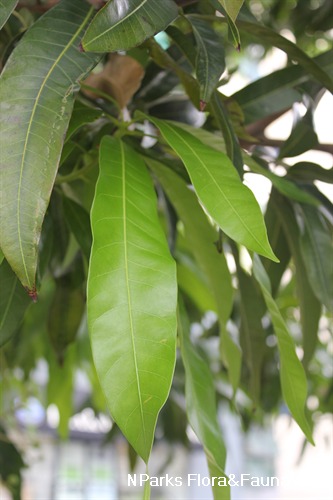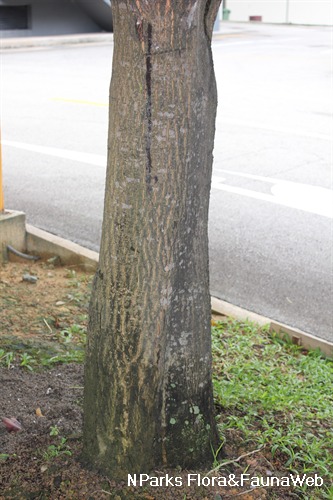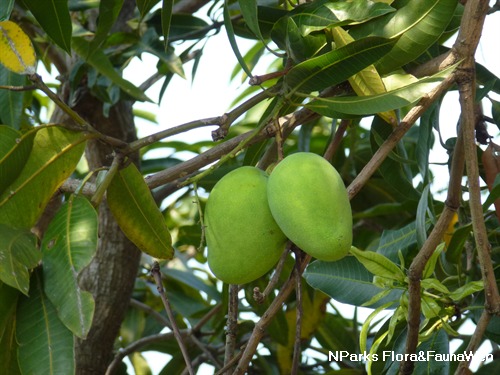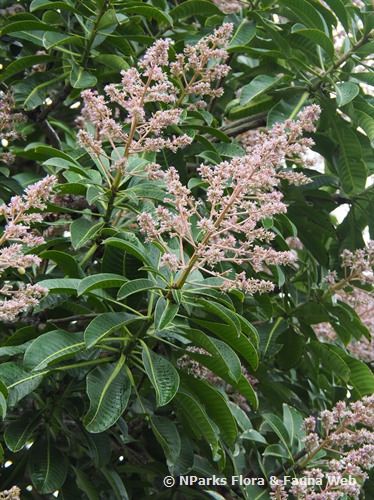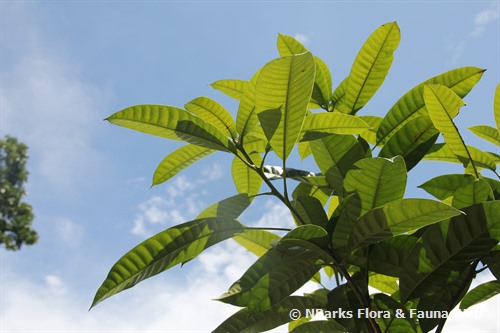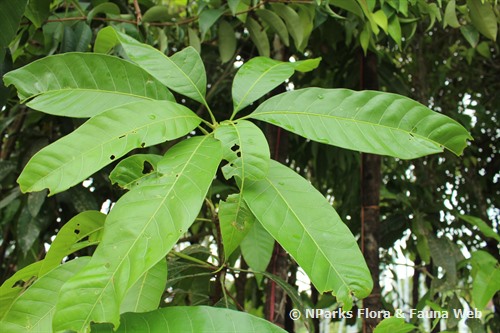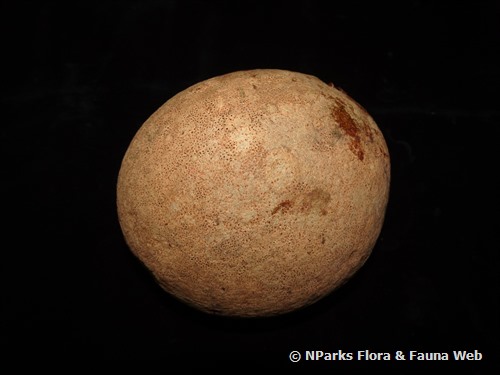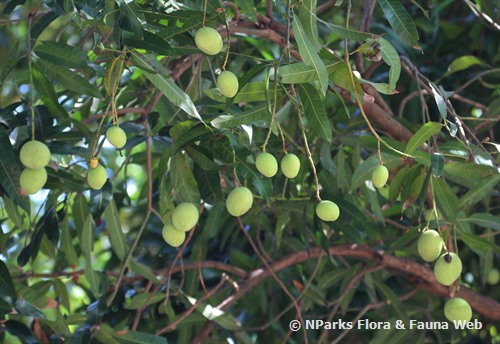
Back
Mangifera indica L.
| Family Name: | Anacardiaceae |
| Common Name: | Mango, Mangga, Mempelam, Pauh, Mangas, Mempalam 芒果 |
Name
Classifications and Characteristics
| Plant Division | Angiosperms (Flowering Seed Plants) (Dicotyledon) |
|---|---|
| Plant Growth Form | Tree (Big (>30m)) |
| Lifespan (in Singapore) | Perennial |
| Mode of Nutrition | Autotrophic |
| Plant Shape | Broad / Mushroom / Hemispherical |
| Maximum Height | 30 m to 35 m |
| Maximum Plant Spread / Crown Width | 10 m |
Biogeography
| Native Distribution | India, Indochina |
|---|---|
| Preferred Climate Zone | Tropical, Sub-Tropical / Monsoonal |
Description and Ethnobotany
| Growth Form | A medium to large sized tree with a dense, rounded crown with rather distinctive drooping elliptic to lanceolate leaves. It is still relatively common in parks, open spaces and community gardens in Singapore. |
|---|---|
| Foliage | The leaves are simple, deep green, up to 30cm long and 7 cm wide, oblong-elliptic to lanceolate in shape, with entire and slightly undulate margins. The midrib is yellow and quite visible, and the leaves also tend to droop downwards slightly. Young flushes are coppery red to bronze in colour. |
| Flowers | Individual flowers are tiny, yellow to pinkish white, but borne on large, showy panicles with red peduncles, and are considered fragrant. Uneven flowering within the same tree has been reported in some cultivated varieties (or cultivars) of mango including the ‘Sensation’ cultivar (Oosthuyse & Jacobs 1996, Reece et al. 1946, Lin & Chen 1981). It is uncertain why uneven flowering occurs. Oosthuyse & Jacobs (1997) found that flowering can be synchronized in ‘Sensation’ trees by pruning the inflorescences. It is possible that the inflorescence may produce hormones that signal other parts of the tree not to flower. Removing the inflorescence may eliminate the source of inhibitory signals, allowing all parts of the tree to flower. Uneven flowering is a beneficial trait in terms of promoting survival of the mango species and results in flowers being available for a longer period of time thus increasing the likelihood of successful pollination. It also prevents unfavourable weather conditions from destroying the entire crop, because dry weather is required for optimal fruit production. |
| Fruit | The most famous part of this tree, the fruit is a large drupe, up to 20cm long, ovoid-oblong in shape, with green, yellow or red skin often slightly glaucous. It hangs from the branches on long stalks. The flesh when ripe is yellow, juicy and very fragrant. They are relished by humans and animals, including bats, birds, monkeys etc. |
| Associated Fauna | Long-tailed Parakeet, Blue-crowned Hanging Parrot, Oriental Pied Hornbill, Black-naped Oriole, Yellow-vented Bulbul are observed to feed on the fruit. |
| Cultivation | Requires full sun, rich, well-drained soil, and moderate watering. Requires fertilizing with high potassium and phosphate fertilizers if good fruiting is desired. Propagation is by seeds, grafting or budding. |
| Ethnobotanical Uses | Edible Plant Parts : Edible Fruits Food (Herb or Spice) (Fruit or Vegetable) Medicinal: The fruit rind(peel) is consider as tonic. The leaves produce a cooling effect and are used to treated fever and colds. The charred leaves are applied to warts to remove them. The bark increase the flow of urine and is also used to stop bleeding. The seeds are used to treat colds, coughs, diarrhoea and excessive bleeding during menstruation. The resin is used for skin diseases and to treat syphilis. Cultural / Religious: Heritage Tree : There are 4 individuals of Mangifera indica listed as Heritage Trees in Singapore. To find out more about these trees, please visit the Heritage Tree Register. |
Landscaping Features
| Desirable Plant Features | Fragrant (Flowers) (Day) |
|---|---|
| Landscape Uses | General, Shade Providing Tree / Palm |
Fauna, Pollination and Dispersal
| Fauna Pollination Dispersal Associated Fauna | Bird-Attracting Plant, Butterfly Host Plant |
|---|
Plant Care and Propagation
| Light Preference | Full Sun |
|---|---|
| Water Preference | Moderate Water |
| Plant Growth Rate | Moderate |
| Rootzone Tolerance | Fertile Loamy Soils |
| Maintenance Requirements | Low |
| Propagation Method | Seed, Stem Cutting, Grafting, Marcotting, Air-Layering |
Foliar
| Foliage Retention | Evergreen |
|---|---|
| Mature Foliage Colour(s) | Green, Yellow / Golden |
| Mature Foliage Texture(s) | Smooth, Glossy / Shiny, Raised / Sunken Veins |
| Foliar Type | Simple / Unifoliate |
| Foliar Arrangement Along Stem | Alternate, Spiral |
| Foliar Shape(s) | Non-Palm Foliage (Linear) |
| Foliar Venation | Pinnate / Net |
| Foliar Margin | Entire |
| Foliar Apex - Tip | Acuminate |
| Foliar Base | Acute |
| Leaf Area Index (LAI) for Green Plot Ratio | 4.0 (Tree - Dense Canopy) |
Non - Foliar and Storage
| Trunk Type (Non Palm) | Woody |
|---|---|
| Mature Bark Texture | Fissured |
| Stem Type & Modification | Woody |
| Root Type | Underground (Tap Root, Fibrous Root) |
Floral (Angiosperm)
| Flower & Plant Sexuality | Bisexual Flowers |
| Flower Colour(s) | White, Yellow / Golden |
|---|---|
| Flower Symmetry | Radial |
| Flower Size - Remarks | 5mm |
| Inflorescence Type | Panicle |
| Flowering Habit | Polycarpic |
| Inflorescence Size Remarks | Yellow portion of the petals turn brownish. |
Fruit, Seed and Spore
| Mature Fruit Colour(s) | Green, Pink, Yellow / Golden |
|---|---|
| Fruit Classification | Simple Fruit |
| Fruit Type | Fleshy Fruit , Drupe |
Image Repository
Others
| Master ID | 1720 |
|---|---|
| Species ID | 3013 |
| Flora Disclaimer | The information in this website has been compiled from reliable sources, such as reference works on medicinal plants. It is not a substitute for medical advice or treatment and NParks does not purport to provide any medical advice. Readers should always consult his/her physician before using or consuming a plant for medicinal purposes. |

